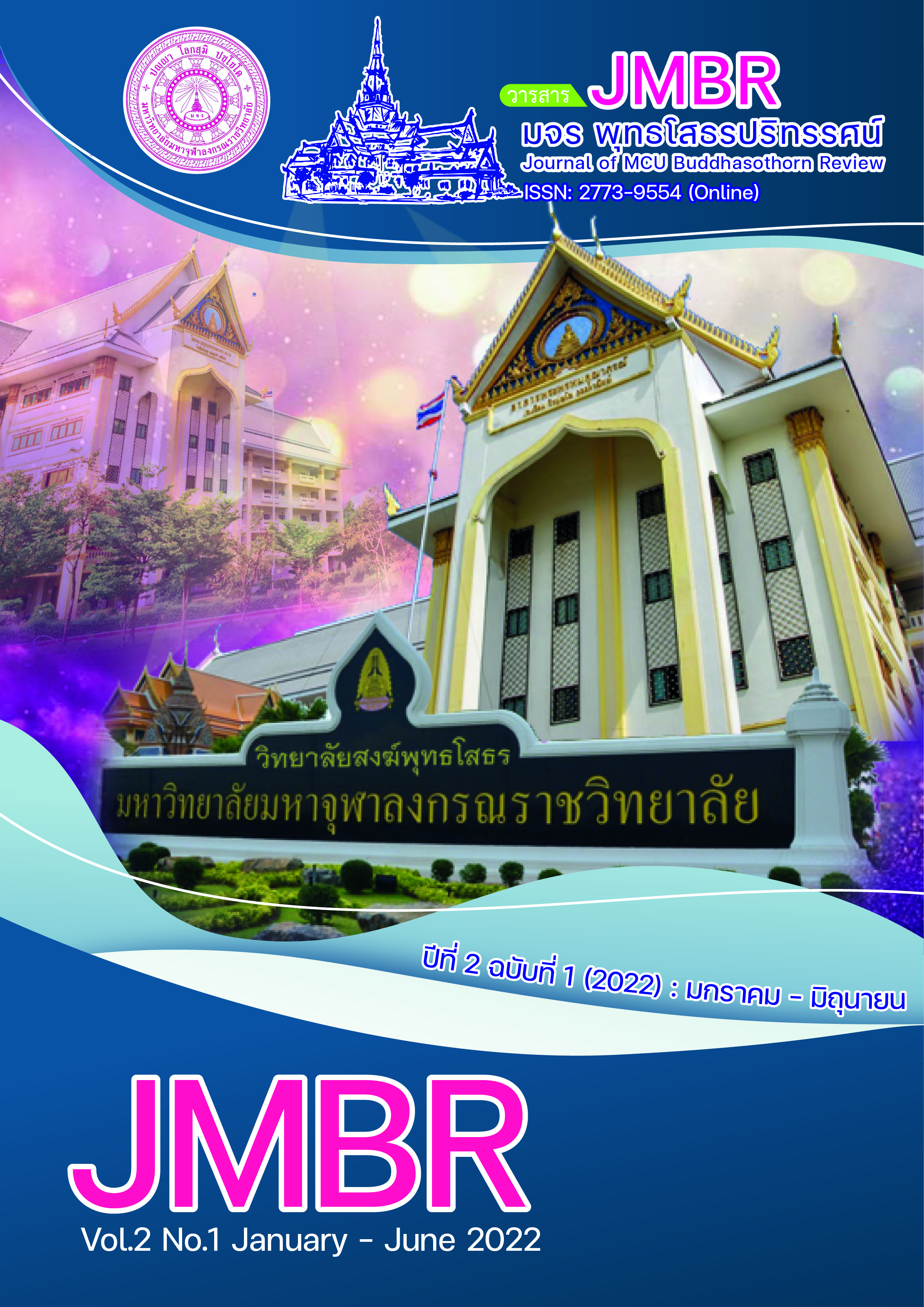Guidelines for the implementation of the principle of Analytic insight in the description of Dharma.
Main Article Content
Abstract
The objectives of this article were to study the reciprocity in the Wiphatti Sutta, to analyze the use of the principle of Analytic insight in the description of Dharma. The data were collected from the Tipitaka and the concerned documents.
The findings are as follows. Firstly, The Wiphatti Sutta for the classification of analytic insight. Speaking of Phra Saribut, you have been ordained for half a month and made an announcement. The name of analytic insight of consequence. Knowledge of clarity in the dharma, which can be considered, enlightenment and determination of the category of dharma is called analytic insight of origin. Knowledge of eloquence in utterance, which is capable of determining clarification and determination of the genre of Niruti. It's called analytic insight of philology. The knowledge of the intelligence in which the intelligence can be made into consideration, clarification and determination of the genre of improvisation. It's called analytic insight of ready wit. In the commentary.
The second guidelines for the implementation of the principle of Analytic insight in the description of Dharma. By considering the relationship of the 4 analytic insight as follows: 1) analytic insight of consequence = understanding of results, meaning of dharma 2) analytic insight of origin = understanding of reason, topic of Dharma 3) analytic insight of philology = understanding language to convey understanding of results and understanding Understand why 4) analytic insight of ready wit = Fluency. Use language understanding to convey an understanding of the results and an understanding of the cause. In summary, it is the practice of language communication skills. Convey an understanding of the result and an understanding of the cause to be understood correctly, clearly.
Article Details

This work is licensed under a Creative Commons Attribution-NonCommercial-NoDerivatives 4.0 International License.
ต้นฉบับที่ได้รับการตีพิมพ์ในวารสาร มจร พุทธโสธรปริทรรศน์ วิทยาลัยสงฆ์พุทธโสธร มหาวิทยาลัยมหาจุฬาลงกรณราชวิทยาลัย ถือเป็นกรรมสิทธิ์ของวิทยาลัยสงฆ์พุทธโสธร มหาวิทยาลัยมหาจุฬาลงกรณราชวิทยาลัย ห้ามนำข้อความทั้งหมดหรือบางส่วนไปพิมพ์ซ้ำ เว้นเสีย แต่ว่าจะได้รับอนุญาตจากวิทยาลัยฯ เป็นลายลักษณ์อักษร และเพื่อให้เป็นไปตามกฎหมายลิขสิทธิ์ ผู้เขียนทุกท่านต้องลงลายมือชื่อในแบบฟอร์มใบมอบลิขสิทธิ์ บทความให้แก่วารสาร พร้อมกับบทความต้นฉบับที่ได้แก้ไขครั้งสุดท้าย นอกจากนี้ ผู้เขียนทุกท่านต้องยืนยันว่าบทความต้นฉบับที่ส่งมาตีพิมพ์นั้น ได้ส่งมาตีพิมพ์เฉพาะในวารสาร มจร พุทธโสธรปริทรรศน์ เพียงแห่งเดียวเท่านั้น
References
ธีรภัทร์ มะกา. (2553). ภาษากับความคิดในวรรณกรรมพุทธศาสนาเรื่องมิลินทปัญหา (วิทยานิพนธ์ปริญญาศิลปศาสตรมหาบัณฑิต). มหาสารคาม: มหาวิทยาลัยมหาสารคาม.
ประพันธ์ ศุภษร. (2550). การศึกษาวิเคราะห์พัฒนาการแห่งการตอบปัญหาเรื่องกรรมกับอนัตตาในพระพุทธศาสนาเถรวาท (วิทยานิพนธ์ปริญญาพุทธศาสตรดุษฎีบัณฑิต). กรุงเทพฯ: มหาวิทยาลัยมหาจุฬาลงกรณราชวิทยาลัย.
พระติปิฎกจูฬาภยเถระ รจนา. (2559). คัมภีร์มิลินทปัญหาภาษาไทย ฉบับมหาวิทยาลัยมหาจุฬาลงกรณราชวิทยาลัย. กรุงเทพฯ: มหาจุฬาลงกรณราชวิทยาลัย.
พระมหานามเถระ รจนา. (2559). สัทธัมมปกาสินีภาษาไทย ฉบับมหาวิทยาลัยมหาจุฬาลงกรณราชวิทยาลัย. กรุงเทพฯ: มหาจุฬาลงกรณราชวิทยาลัย.
พระมหาลิขิต คำหงษา. (2545). ศิลปะการใช้ภาษาในวรรณกรรมเรื่องมิลินทปัญหา (การศึกษาค้นคว้าอิสระหลักสูตรปริญญาการศึกษามหาบัณฑิต). มหาสารคาม: มหาวิทยาลัยมหาสารคาม.
พระมหาวิสิษฐ์ ปญฺญาวฑฺฒโน (กฤษวี). (2545). การศึกษาเชิงวิเคราะห์เรื่องอุปมาในมิลินทปัญหา (วิทยานิพนธ์ปริญญาพุทธศาสตรมหาบัณฑิต). กรุงเทพฯ: มหาวิทยาลัยมหาจุฬาลงกรณราชวิทยาลัย.
มหาจุฬาลงกรณราชวิทยาลัย. (2539). พระไตรปิฎกภาษาไทย. กรุงเทพฯ: มหาวิทยาลัยมหาจุฬาลงกรณราช วิทยาลัย.
มหามกุฏราชวิทยาลัย. (2525). พระไตรปิฎกและอรรถกถาภาษาไทย. กรุงเทพฯ: มหามกุฏราชวิทยาลัย.
สมเด็จพระพุทธโฆษาจารย์ (ป.อ. ปยุตฺโต). (2561). พุทธธรรม. (พิมพ์ครั้งที่ 50). กรุงเทพฯ: สำนักพิมพ์เพ็ทแอนด์โฮม.
สำนักงานคณะกรรมการการอุดมศึกษา. (2551). กรอบแผนอุดมศึกษาระยะยาว 15 ปี ฉบับที่ 2 ปี พ.ศ. 2551-2565. กรุงเทพฯ: จุฬาลงกรณ์มหาวิทยาลัย.


